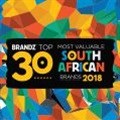Panel discussions are notoriously difficult to report back on, but I couldn't resist sharing insights from a selection of the country's most valuable brands on factors that enhance the value they provide customers as per last week's Kantar Millward Brown SA BrandZ launch.

Viviers, Van Zyl, Salama and Tshukutswane at the BrandZ Cape Town panel discussion.
Following a vibrant, drum-filled launch at the opening of the Johannesburg Stock Exchange (JSE) the day before, the Cape Town version of WPP group and Kantar Millward Brown’s BrandZ report for South Africa took place at their scenic offices on the Foreshore.
Charles Foster, CEO of the insights division for Kantar Africa and Middle East, opened the session by explaining it’s been roughly a 10-year battle to get the SA version of this global study to light, and it’s exciting to finally have a benchmark of studies in this market.
Sharing insight into the global highlights, Foster mentioned that Google and Apple dominate, with the tech industry extremely well-represented. In fact, globally, only non-tech brand listed in the top 10 is McDonald’s.
Foster explained that when looking specifically at the SA study, we need to remember the focus is on brands which are bred here, which excludes the likes of KFC.
The inclusion of financials means that large private companies aren’t included either, and as the focus is on specific brands, holding companies like Tiger Brands and Unilever are excluded. Interestingly, not a single tech brand appears on the inaugural South African list, but many of the brands do use technology to create value.
Two of those brands are Woolworths and Capitec.
Woolworths rose to the top as one of the year’s most “meaningfully different” brands, which makes a difference to consumers by meeting their functional and emotional needs to create affinity; while also creating a difference by being perceived as distinctive, giving them a competitive edge.
They drive strong brand purpose, offer a unique brand experience and amplify this through great market communication. Woolworth’s also received a special award for best brand experience overall.
Capitec bank was named this year’s most innovative brand. Capitec adopted technological disruption to distinguish themselves from competitors through biometric security, but there’s more to it than that.
Powering CX with technology
In a panel discussion following the keynote presentations of the morning, Kantar TNS South Africa CEO Ivan Moroke spoke about the power of technology with panellists Francois Viviers, marketing and communications executive at Capitec; as well as Charlene Van Zyl, head of customer at Woolworths; Tshego Tshukutswane, director at Kantar; and Eric Salama, Kantar’s global CEO.
On innovative banking, Viviers said, “if you can go to Woolworths on a Sunday, you should be able to do your banking then, too.” That’s what you get from Capitec. Another standout factor is that they got rid of the extensive security required to just enter most banks, as well as those confusing queues that often lead to the wrong banking department.
In addition:
Poor people really need good value, and those who have money want a bargain.
That’s why there’s only one banking option at Capitec, it’s not tiered based on earnings.
Capitec continues to prove its value by disrupting from what people expect of the industry. Their #RethinkCredit ad offers helpful advice most us don’t get elsewhere, instead of the beautiful vignettes capped by a banking logo, which could belong to any financial institution.
On using tech for experience, Van Zyl opened by asking if you’ve ever noticed that your local Woolies is always cold, even if you’re nowhere near the freezers. The reason is that temperature control is linked to quality. You’re unconsciously thinking the food is fresher as it’s being kept chilly.
Why we love Woolies
Van Zyl added that brand experience is becoming more than consistency when you go into a branch of a well-known brand. At Woolworths, they’re using technology to understand customers’ shifting needs, and then adjust what’s offered per store.
In retail, particularly online, you need to understand what your customers browse for and how they browse so that you don’t repeatedly show pictures of juicy, raw steaks to vegetarians. But there is a fine line between stalking and being intimate.
Van Zyl added that the role of marketing isn’t as clean-cut as it used to be. Brand building of today needs a cross-functioning team, and we need disruption in the way most companies are organised functionally in silos. Business just doesn’t happen along those staid, well-work pathways anymore.
On differentiation and uniqueness, Tshukutswane said brands are not connected to culture as much as they should be, especially in terms of the value and meaning that adds to people’s lives.
The context of culture
She also pointed out that distinctiveness doesn’t just happen. You need a capable marketing team, with a wide-lens view of the market, to turn that understanding of the market into what you offer your customers. You then need to articulate the value you add, and communicate it clearly. Tshukutswane says, “be courageous and stay the course.”
On what SA marketers should leverage more - with his outside-in view, Salama said he went onto the Nando’s South Africa website and didn’t understand the bulk of the content.
That’s a good thing as it proves it’s relevant, contextual and correct for the local market. Salama added that local brands are growing at the expense of global brands, as they just don’t have that agility and cultural relevance that Tshukutswane highlighted.
Salama added that tech and data are enablers to create those strong relationships between the brand and the customer, and that they lead to deeper human understanding for the brand, in all their diversity.But execution is the area where great brands live and die. Brands know what they need to do in theory, but often aren’t brave enough to do it.
Salama also echoed Van Zyl’s point that we need to step away from the siloed businesses we have built.
The benefits of being 'same-same, but different'
We need conflict and diversity of opinion to challenge group norms because the truly deep insights don’t look from looking at the averages but from the outliers and what’s easy to miss on the margins; from what’s small yet growing.
So when people talk of innovation and communication, brands need to realise that it’s just not effective without a diverse workforce.
Moroke added that it’s only going to get harder for brands to avoid taking a cultural stance, but to do your research first as doing so requires both bravery and taking calculated risks. In addition, we need to turn insights from something fluffy into something based on true monetary value, to create credible conversations and overall customer experiences.
Viviers concluded that brands will not survive if the marketing strategy is not tied to the business strategy.
Click through to the Kantar Millward Brown press office and follow their brand and the #BrandZSA hashtag on Twitter for the latest updates.
Read more






































